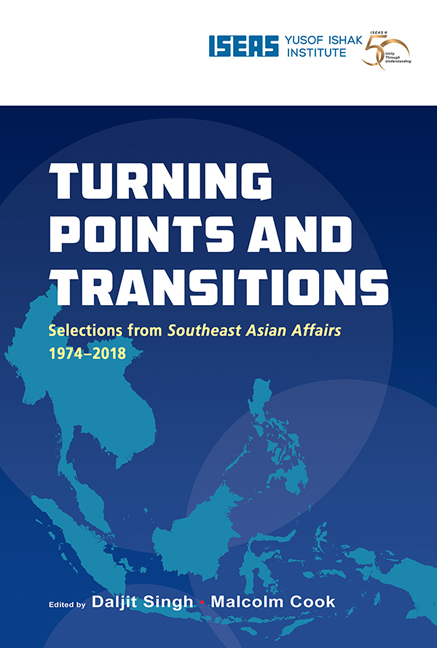Book contents
- Frontmatter
- Contents
- Message from the Director
- Foreword
- Foreword
- Introduction
- THE REGION
- The Diplomatic Emergence of China and Its Implications for Southeast Asia (1975*)
- Stability and Security in the Region after ANZUK (1975)
- The Question of the “Overseas Chinese” (1976)
- Southeast Asia 1976: The Handling of Contradictions (1977)
- The “Fukuda Doctrine” and Its Implications for Southeast Asia (1978)
- Expanding Horizons in Southeast Asia? (1994)
- AFTA in the Light of New Economic Developments (1995)
- The ASEAN Economic Miracle Unravels (1999)
- Southeast Asia in 1999: A False Dawn? (2000)
- East Timor's Future: Southeast Asian or South Pacific? (2001)
- Southeast Asia in 2002: From Bali to Iraq — Co-operating for Security (2003)
- The Year in ASEAN: The Charter, Trade Agreements, and the Global Economic Crisis (2010)
- Seeking Stability in Turbulent Times: Southeast Asia's New Normal? (2015)
- China's Two Silk Roads Initiative: What It Means for Southeast Asia (2015)
- China's International Strategy and Its Implications for Southeast Asia (2016)
- BRUNEI
- CAMBODIA
- INDONESIA
- LAOS
- MALAYSIA
- MYANMAR
- THE PHILIPPINES
- SINGAPORE
- THAILAND
- VIETNAM
Southeast Asia in 2002: From Bali to Iraq — Co-operating for Security (2003)
from THE REGION
Published online by Cambridge University Press: 29 May 2019
- Frontmatter
- Contents
- Message from the Director
- Foreword
- Foreword
- Introduction
- THE REGION
- The Diplomatic Emergence of China and Its Implications for Southeast Asia (1975*)
- Stability and Security in the Region after ANZUK (1975)
- The Question of the “Overseas Chinese” (1976)
- Southeast Asia 1976: The Handling of Contradictions (1977)
- The “Fukuda Doctrine” and Its Implications for Southeast Asia (1978)
- Expanding Horizons in Southeast Asia? (1994)
- AFTA in the Light of New Economic Developments (1995)
- The ASEAN Economic Miracle Unravels (1999)
- Southeast Asia in 1999: A False Dawn? (2000)
- East Timor's Future: Southeast Asian or South Pacific? (2001)
- Southeast Asia in 2002: From Bali to Iraq — Co-operating for Security (2003)
- The Year in ASEAN: The Charter, Trade Agreements, and the Global Economic Crisis (2010)
- Seeking Stability in Turbulent Times: Southeast Asia's New Normal? (2015)
- China's Two Silk Roads Initiative: What It Means for Southeast Asia (2015)
- China's International Strategy and Its Implications for Southeast Asia (2016)
- BRUNEI
- CAMBODIA
- INDONESIA
- LAOS
- MALAYSIA
- MYANMAR
- THE PHILIPPINES
- SINGAPORE
- THAILAND
- VIETNAM
Summary
Introduction
The region's recovery from the destabilizing effects of the 1997/98 Asian economic/ financial crisis had been patchy, and although by 2002 most gross domestic product (GDP) levels had edged back to pre-crisis levels, per capita incomes had not and unemployment was on the rise. The 3.5 per cent growth in Indonesia was achieved over a low baseline. Its path towards economic restructuring, sustained economic recovery, and political stability remained tortuous.
On the road to economic recovery two developments set back confidence and fuelled uncertainties. The Al-Qaeda terrorist attacks on the United States on 11 September 2001 (commonly referred to as “9/11”) opened a new phase of international insecurity. How the United States would pursue the war against global terrorism and with what impacts on the Muslim world fuelled uncertainty. The more open regional economies focussed on the consequences for global travel, business confidence, and the international economy. In retrospect neither the United States nor the most open regional economy, Singapore, was too seriously affected. Within a year both economies had rebounded with Singapore in the third quarter of 2002 seemingly headed for a 4 per cent growth. In 2002 the Malaysian economy grew by 4.2 per cent while the fastest regional growth rate of 7 per cent was recorded by Vietnam. However, the terrorist bombings in Bali on 12 October 2002, which killed 202 people, many of them foreign tourists including 88 Australians, dampened expectations of a rebound as Southeast Asia initially acquired an undifferentiated image in the minds of foreign investors and in travel advisories as an insecure region.
American concerns that parts of maritime Southeast Asia with their local history of Muslim militancy and rebellion against central authority were vulnerable to penetration by the Al-Qaeda network in search of a “second front” resurfaced following the Afghanistan campaign which commenced in October 2001 and resulted subsequently in the destruction of the Taliban regime and disruption of the Al- Qaeda network. The year 2002 began with regional anticipation of the political fallout of the war against international terrorism and ended with nervous tension over the imminence of war in Iraq.
- Type
- Chapter
- Information
- Turning Points and TransitionsSelections from Southeast Asian Affairs 1974-2018, pp. 112 - 125Publisher: ISEAS–Yusof Ishak InstitutePrint publication year: 2018



